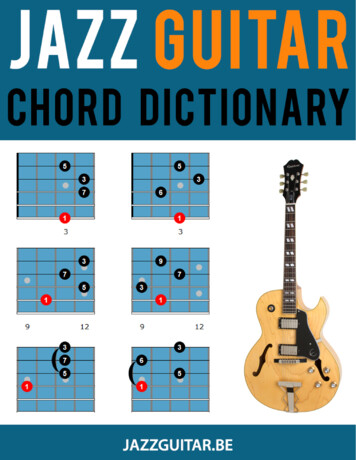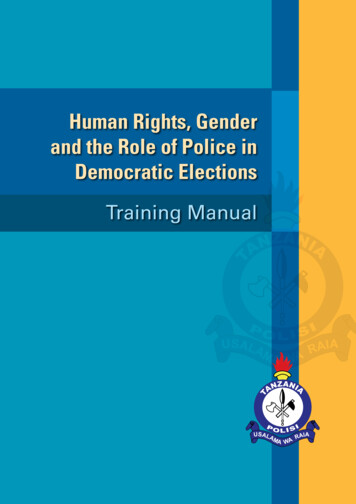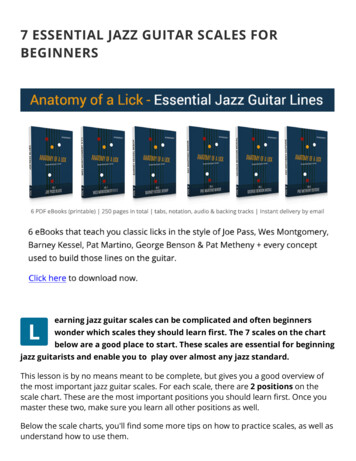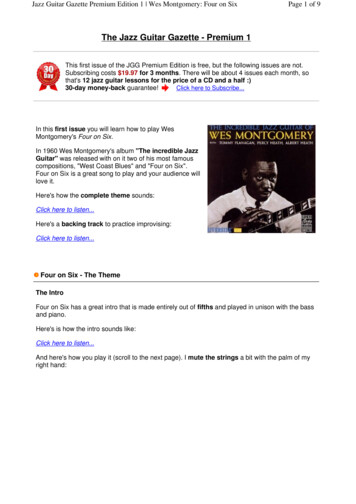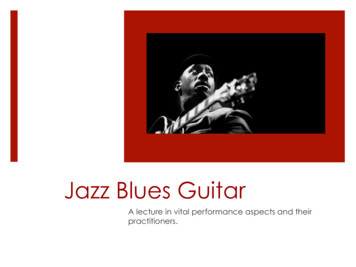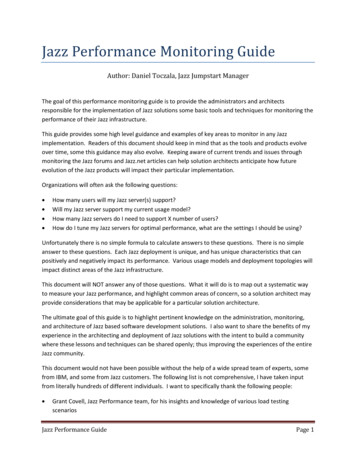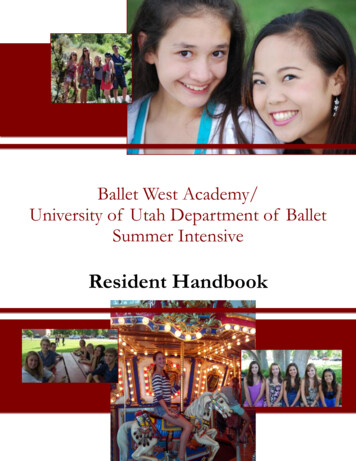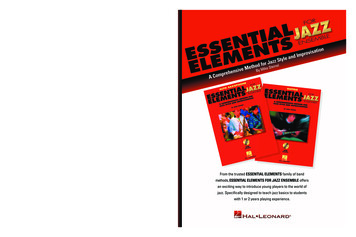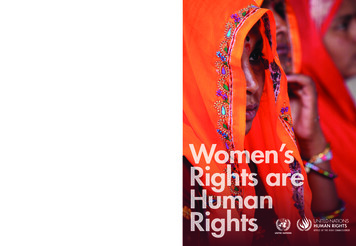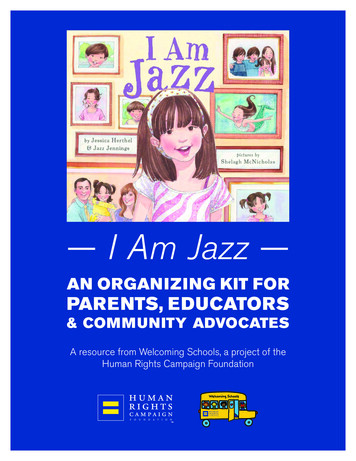
Transcription
— I Am Jazz —AN ORGANIZING KIT FORPARENTS, EDUCATORS& COMMUNITY ADVOCATESA resource from Welcoming Schools, a project of theHuman Rights Campaign Foundationwww.hrc.org/iamjazz
Community Readings of I Am Jazz to Support Transgender YouthIn late 2015, an elementary school in Mount Horeb, Wis., planned a reading and discussion of achildren’s book as part of their efforts to support one of the school’s students — a six-year-oldtransgender child who had recently socially transitioned and was attending the school openly asthe girl she knew herself to be. The book, I Am Jazz, is a picture book based on earlyexperiences of transgender youth and advocate Jazz Jennings.Prior to the reading, an anti-LGBT hate group learned of the event and threatened to sue theschool, calling for the school to cancel the discussion. But the Mount Horeb community ralliedbehind the school and the transgender student.A parent in the community organized a reading of I Am Jazz at the local library. The audience —full of children, parents, grandparents and community members — put courage before fear andturned out to learn more about how they could support the full humanity of transgender childrenand youth in their own backyard.In 2016, communities all across the nation hosted their own events — inspired by the MountHoreb community. They were held in schools, libraries, churches, temples, and bookstores. I AmJazz was even read aloud on the floor of the U.S. House of Representatives.The Human Rights Campaign — through the HRC Foundation’s Welcoming Schools program —is encouraging parents, teachers, students, school administrators and communities to create theirown readings in support of transgender youth.These events help children and youth know theyare welcomed and loved in their communities.The HRC Foundation has created this guide tohelp organizers to build more affirming andsupportive spaces for transgender and nonbinary children and youth across the country.HRCF’s Welcoming Schools program alsoprovides additional resources and professionaldevelopment to schools across the UnitedStates. Visit www.welcomingschools.org.About the Book, I Am JazzI Am Jazz is a first-person account about being transgender by transgender youth and advocateJazz Jennings and her co-author Jessica Herthel. Jennings was one of the first transgenderchildren to talk publicly about her identity and the challenges she has faced as a transgenderyouth. Herthel is not transgender, nor does she have any transgender children. She co-wrote thebook based on her experience explaining to her daughters what “transgender” meant, hoping tocreate a book that other parents and caring adults would be able to use to start conversationswith their kids. The book takes less than five minutes to read, and is appropriate for all ages.
Organizing a Reading of I Am JazzCreating welcoming spaces for transgender and non-binary children and youth can start withsomething as simple as a conversation — between colleagues or neighbors, among educators inthe teacher’s lounge, in classrooms and hallways, or in more formal settings like a communityforum or school-wide assembly. What is important is making sure that these conversationshappen in safe and productive ways.Here are some ideas for getting those conversations started with a reading of I Am Jazz:In your school – If you’re a principal or otherschool administrator, consider having a schoolwide assembly and reading I Am Jazz to theentire school. Teachers can use this discussionguide to have conversations in small groups or intheir classrooms. In the library, you could arrangefor classes to have a discussion about the book.In your community – Organize a reading anddiscussion that is open to all members of yourcommunity at a local library or school auditorium. Invite prominent local leaders to participate andencourage attendees to bring the whole family. Use social media to create an invitation andspread the word. (See below for ideas)In the classroom – If you’re an elementary school teacher, consider reading I Am Jazz to yourclass, just like you would do with any other children’s book – use the Welcoming Schools lessonplan for I Am Jazz that is aligned with national standards; use some of the discussion prompts inthis guide; or integrate the reading into your social emotional learning program on developingempathy or preventing bullying.In your place of worship – If you belong to a church, temple or mosque, plan a reading anddiscussion within your community. Open it to the wider community as well.If you’re a parent, consider giving a copy of I Am Jazz to your child’s teacher and asking if it canbe read in the classroom — and share this guide with them. Read it with your children at home ororganize a reading in a community location!After your reading or lesson, the conversation doesn’t end! Help ensure there are inclusive antibullying policies in your schools. Read other books that look at gender to continue the discussion.Examine your own practices to make sure that you’re helping all young people to thrive.Promoting Your Event:For some organizers, these will be school events. For others, these events will be taking place inlibraries, community centers and other public locations.
If you’re planning a public event, help raise awareness and a crowd for your event. Here are afew tips that can help: Publicize on social media.o Do you have a Facebook, Twitter or Instagram account?o Share on your personal and/or public account.o Post on any pages or “groups” that you belong to.o Be sure to do this several times – just because you postonce doesn’t mean that people will see it.o Tag the Human Rights Campaign on Facebook and usethe hashtag #CloseTheBookOnHate, so we can helpspread the word.o Use images to help people notice your posting. (Cover image from I Am Jazz attached) Make an event page on Facebook to help encourage people to RSVP. (To create an event,click Events in the left menu of your News Feed.) Invite local leaders (i.e. elected officials, School Board members, supportive communitymembers, local leaders of LGBTQ organizations, etc). If they accept, encourage them to alsoshare with their audiences. Distribute fliers at your local library, put on bulletin boards in supportive locations, and bringsome to a local community center or LGBTQ center. (Click here for a flier template) Share information about your event on a listserv. Are you part of a parents listserv, alistserv for your congregation, or community list? Send out information a week or two prior to the event, a few days before, the day before, andthe day of the event to remind people to attend. Submit to your local community calendar. Most outlets allow you to do this via a website.Sample language for social sharing:Facebook:Join me and the Human Rights Campaign for a reading of I Am Jazz, a book by transgender teenAmbassador Jazz Jennings! (Include details here or make a Facebook event page for RSVPs.)Show your support for transgender youth. Join me and the Human Rights Campaign for a readingof Jazz Jennings’ book “I am Jazz.” RSVP at (share details).Don’t forget to join me for a reading of I Am Jazz, a book by transgender teen and Human RightsCampaign Foundation Youth Ambassador Jazz Jennings. (share details)Jazz Jennings’ book I Am Jazz plays an important role in helping communities understandtransgender youth. Join me for a reading of Jazz’s book next week/tomorrow/today (share details)
Twitter:Hashtags: #CloseTheBookOnHate, #HRC, #IAmJazz, #WelcomingSchoolsJoin me and @HRC for a reading of I Am Jazz, a picture book by transgender teen@JazzJennings #CloseTheBookOnHateIt’s not too late, join me and @HRC for a reading of I Am Jazz, by transgender teen@JazzJennings tonight! #CloseTheBookOnHateWATCH: These amazing moms are standing up for their trans kids @HRC#CloseTheBookOnHate #trans https://www.youtube.com/watch?v oysepu0LWEkWATCH: These amazing dads are standing up for their trans kids @HRC#CloseTheBookOnHate #trans https://www.youtube.com/watch?v rl7RLbt OOESome Considerations Before Your EventWho should do the reading itself?Is there a teacher, school official, family member or community member who would be willingto do the reading or help facilitate the discussion? Are there advocates or other experts in yourcommunity who might be willing to lend their expertise to the discussion and help draw a friendlycrowd? Keep in mind that just because a teacher is gay or a parent in your school is transgender,they may not want to be the person to read the book. Having an ally do the reading is equallyas powerful.Consider your audience.Are you talking to a classroom of elementarystudents or a large group of students with theirfamilies? Consider your audience when decidingwhat questions to discuss (see ideas below) andhow to structure the event. For example, aquestion and answer session with a few panelistsmight work best for a large group, while aninteractive group discussion might be better suitedto a small group or classroom.Be prepared for questions.In most cases, there will be people at your event who don’t have a lot of background knowledgeon what it means to be transgender. They may ask questions that seem rude or inappropriate orthat you do not have an answer to. Most people, however, are simply lacking information, and thisevent can help by providing accurate information. If someone asks you a question and you’reunsure of the answer, it’s okay to say that you don’t know!In preparation, check out our talking points for answers to some of the questions or concerns thatmay arise and look at the resources listed in this guide.
Important Talking Points A transgender person is someone whose gender identity is different from the sex they wereassigned at birth. Transgender children, just like all children, need safe and supportiveenvironments in which to live and learn. People express their gender in many different ways. There is no right or wrong way to be aboy, girl, both or neither. There is no such thing as a “boys’ color” or a “toy for girls”; everychild should be allowed to express themselves however they want regardless of gender. Diversity and difference are important to be recognized by children and adults. Celebratingdiversity creates schools and communities where all youth and their families can feel safe andsupported. Students are already learning and talking about gender and difference. By guiding thosediscussions, families, educators and other caring adults can prevent bias-based bullying,harassment and gender stereotyping.Questions for DiscussionFor Children:Everybody has different levels of understanding or experience with hearing about or knowingtransgender people. Help your students to feel comfortable asking questions and assuring themit’s OK if they don’t know something. How does Jazz feel when other kids at school make fun of her because she’s transgender? How does it make you feel when someone makes fun of you? What are some of the ways that Jazz talks about being different from her friends? Jazz likes to dance, sing, play soccer, and wear her mermaid tail? Can both boys and girls doall those things? Guide the discussion toward an understanding that there isn’t such a thing as“boys’ toys” or “girls’ colors” or “boys’ haircuts” or “girls’ haircuts.” What makes you feel safe at school? How can you help transgender students feelsafe too? What can you do if you see someone makingfun of another student? (See WelcomingSchools Ally / Bystander lesson) What does being an “ally” mean, and how canyou be an ally at school?
For Parents and Other Adults:Everybody has different levels of understanding or experience with hearing about or knowingtransgender people. Help create a brave space where people feel comfortable asking questions -assuring them it is OK if they don’t know something. What do you appreciate about hearing Jazz’s story? Are there times that you feel like you are not seen for who you are? What does it mean to be transgender? Do you know someone who is transgender? Have you ever talked to your child about transgender people? How does being transgender affect Jazz’s experiences at school? What are some of the ways that you teach your children gender stereotypes, even withoutmeaning to? What words or phrases would you feel comfortable using to help children understand whattransgender means? What are some ways that parents and educators can help children understand gender andappreciate people who are different? What are some ways that parents and educators can help create schools where transgenderand non-binary children feel safe and supported?Other Tools for Your EventAt the event, you may want to offer other resources or even show a video or two to provide moreinformation to your audience. These tools below can help before, during, or after the event. Also,attached to this Organizing Kit are additional resourcesHRC Foundation's Welcoming Schools is the nation's premier professional developmentprogram with training, resources, and lessons dedicated to creating respectful and supportiveelementary schools with training and resources geared specifically to help support transgenderand non-binary students in school. School resources on gender at www.welcomingschools.org.Supporting Transgender Children and Youth Find resources that transgender children,families and other youth-serving professionals need to support one another in their journeys.www.hrc.org/trans-youthSupporting & Caring for Transgender Children is a groundbreaking resource from the HRCFoundation that explains how families and healthcare professionals can help transgenderchildren thrive.Parents for Transgender Equality National Council a coalition of the nation’s leading parentadvocates working for equality and fairness for transgenderpeople. lity-national-council
Moms and Dads for Transgender Equality [videos]: Parental support is critical to all children.Fortunately, more and more parents are standing up for their transgender children. Watch thesevideos of incredible parents with courageous transgender kids, all speaking out in support oftransgender young people.Time to THRIVE Conference: The HRC Foundation, in partnership with the National EducationAssociation and the American Counseling Association, present Time To THRIVE, an annualnational conference to promote safety, inclusion and well-being for LGBTQ youth. everywhere!www.timetothrive.orgChildren’s Books to Help Understand and Support Transgenderand Gender-Expansive YouthBe Who You Are, Todd Parr (Pre-K – K) With Parr’s signature silly andaccessible style, Parr encourages readers to embrace all their unique qualities –reminding them that their unique traits are what make them so special.Big Bob, Little Bob, James Howe (Pre-K – 2) Despite the factthat they share a name, they are different. Big Bob likes trucksand throwing balls and being loud. Little Bob likes dolls and jingling braceletsand being quiet. Yet, they become friends. When aneighbor teases Little Bob about dolls, Big Bob steps in with “Boys cando whatever they want.”George, Alex Gino (3 – 6) When people look at George, they think they see a boy.But she knows she's not a boy. She knows she's a girl. George really wants to playCharlotte in Charlotte’s Web. Will she be able to?I Am Jazz, Jessica Herthel and Jazz Jennings (K – 5) From thetime she was two years old, Jazz knew that she was a girl eventhough everyone thought she was a boy. She loved pink and dressingup as a mermaid and didn't feel like herself in boys' clothing. Basedon the real-life experience of Jazz Jennings.Introducing Teddy: A gentle story about gender andfriendship, Jess Walton (Pre-K – K) Introduces the youngest readers tounderstanding gender identity and transition in an accessible and heartwarming story about being true to yourself and being a good friend.Jacob’s New Dress, Sarah and Ian Hoffman (Pre-K – 2) Jacob loves playingdress-up, when he can be anything he wants to be. Some kids at school say hecan’t wear “girl” clothes, but Jacob wants to wear a dress. Can he convince hisparents to let him wear what he wants? Speaks to the unique challenges faced byboys who don’t identify with traditional gender roles.
My Princess Boy, Cheryl Kilodavis (Pre-K – 1) Dyson loves pink, sparklythings. Sometimes he wears dresses. Sometimes he wears jeans. He likes towear his princess tiara, even when climbing trees. He’s a Princess Boy.The Pants Project, Cat Clarke (3 – 6) Liv knows he was alwaysmeant to be a boy but he hasn’t told anyone – even his two momsyet. Now, his new school has a terrible dress code, he can't even wear pants. Onlyskirts. The only way for Liv to get what he wants is to go after it himself. But to Liv,this isn't just a mission to change the policy―it's a mission to change his life.Red: A Crayon's Story, Michael Hall (Pre-K – 1) A blue crayon mistakenlylabeled as "red" suffers an identity crisis. Almost everyone tries to “help” him bered until a friend offers a new perspective. He’s blue! About finding the courage tobe true to your inner self. This can be read on multiple levels.For additional books, see Welcoming Schools Booklists with great, diversebook recommendations.About HRC Foundation’s Welcoming SchoolsHRC Foundation's Welcoming Schools is the nation's premier professional development programwith training, resources, and lessons dedicated to creating respectful and supportive elementaryschools by: Embracing family diversity Creating LGBTQ- and gender-inclusive schools Preventing bias-based bullying Supporting transgender and non-binary studentsFor more information, visit www.welcomingschools.org.AttachmentsA. I Am Jazz National Day of Action FlyerB. Welcoming Schools I Am Jazz Lesson PlanC. Be Prepared for Gender Put DownsD. Gender and Children: A Place to BeginE. Defining LGBTQ Terms to ChildrenF. Transgender Children: Books to Help Adults UnderstandG. Welcoming Schools Information
NATIONALDAY OFACTIONIN SUPPORT OFTRANSGENDER YOUTHTeachers, librarians, parents andcommunities all across the country areSIGNING UP TOREAD I AM JAZZON MAY 18, 2017,in support of transgender youth.It’s easy. Sign up today and download theorganizing kit to get started.WWW.HRC.ORG/IAMJAZZ
I AM JAZZ: READING A CHILDREN’S BOOK TO HELP UNDERSTANDTRANSGENDER TOPICS IN ELEMENTARY SCHOOLSUGGESTED GRADE LEVEL: K – 5LENGTH OF TIME: 40 minutesGOAL To expand students’ perception and understanding of gender. To understand what it means to be transgender usingdevelopmentally appropriate language for younger students For students to understand ally behavior.OBJECTIVES Students will read and discuss a story based on the true story of a transgender girl.Students will learn new vocabulary words related to gender.Students will learn about difference and being an ally.ACADEMIC STANDARDS CCSS RL 1.1 Ask and answer questions about key details in a text. CCSS RL 3.1 Ask and answer questions to demonstrate understanding of a text,referring explicitly to the text as the basis for the answers. CCSS SL 4.1 Engage effectively in a range of collaborative discussions (one-on-one,in groups, and teacher-led) with diverse partners on grade 4 topics and texts, buildingon others’ ideas and expressing their own clearly.EDUCATORS’ NOTESAbout the BookI Am Jazz is a first-person account about a transgender girl written by transgender teen,Jazz Jennings, and co-author, Jessica Herthel. Jennings was one of the first transgenderchildren to talk publicly about her identity. At the age of 6, she spoke with Barbara Walterson “20/20.” Herthel is not transgender, nor does she have any transgender children. She cowrote the book based on her desire to explain to her daughters what “transgender” means,hoping to create a book that other parents and caring adults would be able to use to startconversations with their kids.Before Reading I Am Jazz to Your Students Read the book yourself and think about what questions you and your students mayhave, and practice how you want to respond. Being prepared will help you to becomfortable with a topic that you may be unfamiliar discussing.o Review the Gender Definitions section, below, to prepare how to answerquestions and lead a class discussion on gender topics.www.welcomingschools.org
o It is important to note that the book simplifies the idea of transgender to “a girlbrain but a boy body,” however, being transgender is about more than just thebrain. One’s gender is about who you know you are deep inside.o For ideas on ways to respond to questions or put-downs about gender, take alook at Welcoming Schools’ handout: Be Prepared for Questions and PutDowns on Gender.o If a student asks you a question and you’re unsure of the answer, it’s okay tosay that you don’t know! You could say you’ll figure it out and get back to them. Ensure that every child in your classroom is allowed to express themselves howeverthey want, regardless of their gender identity or expression---or any aspect of theiridentity that may be considered by other students to be “different”. Understand that gender is a spectrum, not a binary, and that we all express ourselvesin many different ways along that spectrum. Each child is an individual with their ownunique expression of who they are in the world. Messages to students can be as simple as: There is no such thing as a ‘boys’ color’ ora ‘girls’ toy;’ Colors are colors; Toys are toys; Clothes are clothes; and Hair is hair! Students are already learning and talking about gender and difference. They receiveformal and informal messages about gender from a multitude of sources—theirfamilies, peers, communities and the media. Many of the messages empower them,and many of the messages limit them. As such, it is critical to discuss gender in theclassroom. By guiding discussions about gender with students, educators, families and othercaring adults, you can help to prevent bias-based bullying, harassment and genderstereotyping. Finally, it is often important to review classroom rules about respect and being an allywhen having discussions about gender given that gender is a common way thatchildren participate in identity-based bullying.MATERIALS: A copy of the book I Am Jazz by Jazz Jennings and Jessica Herthel.ACTIVITYNote: The book purposefully introduces you to Jazz—what she likes to do, her favoritecolors and her friends—before mentioning that she is transgender. Therefore, read the bookbefore saying that it is a book about a transgender girl. Instead you could simply say that thisis a story based on the real-life experience of a girl named Jazz.Prompts for discussion: Jazz says that her favorite colors are silver and green. What are are your favoritecolors? What about the colors pink or blue? Can boys like pink? Can girls like blue?www.welcomingschools.org
Jazz says she felt sad when she had to wear traditional “boys” clothes? Why do youthink she felt sad? What helped Jazz feel happier? What kinds of things help you feel better aboutyourself? In the book, Jazz says that she is transgender. Who can describe what transgendermeans? Note: Allow students to ask questions. Help to clarify the meaning oftransgender, if students are still not sure about it. Being transgender is just one part of who Jazz is. What are other parts of Jazz thatmake her who she is? How does Jazz feel when other kids at school make fun of her because she’stransgender?o How does it make you feel when someone makes fun of you?o What can you do, if you see someone making fun of another student?Note: Students have many options. Mention some of these ideas if they are notmentioned by your students: Speak-up in the moment; tell an adult such as aparent or teacher; talk to either the student who is being made fun of or thestudent who is being mean later, in private; cause a distraction so the meanteasing stops; or help the student who is getting teased to get away from thesituation.EXTENSIONS Continue the discussion about gender roles and gender stereotypes with some of theadditional books listed below. Watch the music video, I Am Me by Willow Smith. (Available on YouTube) Write “I Am Me” poems. (See the Welcoming Schools’ lesson: Be Who You Are: I AmMe Poems.) Continue the discussion of what students can do if they see someone making fun ofby another student with the Welcoming Schools’ lesson: Making Decisions -- Ally orBystander.ASSESSMENT AND EVALUATION Exit cards asking about one new thing the students learned and anything that they stillhave questions about. Ongoing teacher observation of gender-based teasing, and if it is recognized moreoften or becomes less frequent. Ongoing teacher observation on whether or not students feel comfortable makingchoices outside the gender binary.www.welcomingschools.org
RECOMMENDED BOOKSPicture BooksAnnie’s Plaid Shirt. Stacy B. Davids.Introducing Teddy: A gentle story about gender and friendship. Jess Walton.It’s OK to Be Different by Todd Parr.Jacob’s New Dress by Sarah and Ian Hoffman.Red: A Crayon's Story by Michael Hall.Middle Grade BooksGeorge. Alex Gino.Gracefully Grayson. Ami Polonsky.Lily and Dunkin. Donna Gephart.The Pants Project. Cat Clarke.Riding Freedom. Pam Muñoz Ryan.DEFINITIONSGENDER IDENTITY: How you feel—male, female, neither or both. This can be different fromthe anatomy that you were born with (sex assigned at birth).TRANSGENDER/TRANS: When your gender identity (how you feel) is different thanhow your body is (your anatomy). When a person with a boy body feels like a girl insidetheir heart and brain. Or, when a person with a girl body feels like a boy inside their heartand brain.GENDER EXPANSIVE: This means that here at our school children get to “like what they like.”Toys are toys, hair is hair, clothes are clothes. Children can express themselves fully – to bewho they are without being teased or bullied.GENDER BINARY: The idea that there are two distinct and opposite genders—male andfemale / boy and girl. This idea is limiting and doesn’t allow for the many ways that childrenand adults express themselves.GENDER EXPRESSION: One of the many forms of expression where we share who we are withitems such as our clothes and hair.STEREOTYPE: When you generalize and oversimplify what an entire group of people is like.They are often negative. Stereotypes don’t take into account all of the ways each person isunique. Even a positive stereotype can be hurtful. Stereotypes keep people from being seenas who they are as an individual.GENDER STEREOTYPE: Stereotypes based on social and cultural beliefs or expectations aboutappropriate behavior for men/boys or women/girls. This can limit children’s aspirations,achievements and well-being.www.welcomingschools.org
BE PREPARED FOR QUESTIONS AND PUT-DOWNS ON GENDERPracticing answering questions related to gender or interrupting hurtful teasing based on gender willhelp you respond more easily when the situation arises. As educators, take the time to practicesimple phrases. As teachers, work with your students so that they also have simple responses togender exclusion or put-downs.“Why does Martin like pink?” There doesn’t have to be boy colors or girl colors. Colors are colors. All people likedifferent colors. Do you think it’s wrong for boys to wear pink? Why’s that? Why do you like blue, or green, (or whatever color that child likes)? Why don’t you like pink? Did you know that pink used to be considered a boys color and blue was the girl’s color?“Why is her hair so short? She looks like a boy.” Girls and women can have hair in many different styles and so can boys or men. Hair is hair. That is how she likes it. Why does it matter if a girl’s hair is short or a boy’s hair is long?“Juan plays with dolls. That’s weird.” It’s true that some boys don’t like to play with dolls but some boys do! Just like some of youlike to draw and some of you don’t. Some of you like to play kickball and others don’t. No oneshould have to pick and choose what they do just because they are a boy or a girl. The dolls are for all children in this classroom. Sometimes this is confusing. We get messages about some things being for boys and somethings being for girls. They are just for kids!You overhear a student say to another student who identifies as a girl, “You look like a boy.” Why do you say that? There is no one way for girls or boys to act or look. Girls and women can have short hair. That’s just how she likes it. Those are the kinds of clothes that she likes to wear. Why do you like to wear what you’rewearing?“But he’s a boy, why does he dress like a girl?” There are lots of different ways that boys can dress and lots of different ways that girls candress. Some boys like to wear pink or to have long hair. All of these things are OK in our school. There are many ways of being a boy (girl), and all are okay ways of being a boy (girl). Those are the kinds of clothes that he likes to wear? Why do you like to wear what you’rewearing?“Dominic is always hanging out with girls. Why?” I encourage all children to play together. Dominic hangs out with friends who he likes to spend time with, just like you do withyour friends. Some boys like the activities that more of the girls are doing and therefore like to playwith girls.www.welcomingschools.org
You overhear a student call another student who identifies as a boy, a “girl” in aninsulting way. That’s not OK at our school to call someone a “girl” to insult them or make them feel bad. Student: “But he is always playing with the girls and with girl toys!” At this school all children can play and do things together. He’s a boy who likes to playwith girls and that’s OK. All kinds of toys and games are for all children.“Why does she always play with the boys?” Those are the activities that she likes to do just as there are different activities that youlike to do. There are many different ways of bei
of Jazz Jennings’ book “I am Jazz.” RSVP at (share details). Don’t forget to join me for a reading of I Am Jazz, a book by transgender teen and Human Rights Campaign Foundation Youth Ambassador Jazz Jennings. (share details) Jazz Jennings’ book I Am Jazz plays an important
